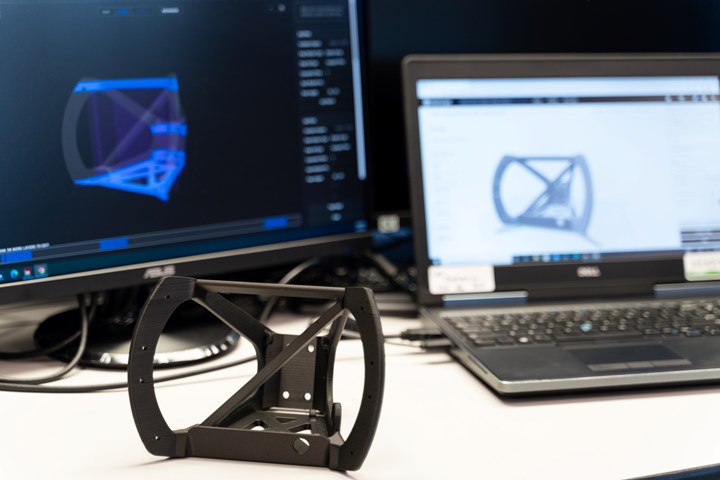Markforged Simulation software features virtual testing capability
Virtual testing validates the strength of advanced composite parts and automatically optimizes print parameters to help lower cost and speed production.
Markforged (Watertown, Mass., U.S.) has released new Simulation features for its additive manufacturing (AM) software, which is used to develop advanced composite parts. Simulation, which works within the company’s Eiger software slice and print workflow, is available as a free trial until April 2023, and the company expects to make the feature accessible through a paid subscription thereafter.
An added feature is virtual testing, which Markforged says will replace slow and costly design/print/break testing cycles, enabling manufacturers to expand their use of AM into the most demanding production applications. Using Simulation, the company says that any user can validate part strength and stiffness through virtual testing by identifying anchor and load surfaces and then entering values for loads, factor of safety and maximum deflection. They can then optimize parts by automatically determining print settings for floors, walls, infill and fiber reinforcement to achieve print cost and speed goals while maintaining adequate strength.
“Simulation enables our customers to adopt The Digital Forge deeper into their manufacturing operations by replacing more mission-critical tooling and end-use metal parts with validated and optimized 3D-printed advanced composite parts with continuous fiber reinforcement,” Shai Terem, president and CEO of Markforged, says. “Cloud-based software innovation like Simulation is core to our mission to bring industrial part production to the point of need.”
Markforged refers to a customer, Larsen Motorsports (Palm Bay, Fla., U.S.), which builds jet engine drag racing vehicles that reach more than 280 miles per hour. The company used Simulation to design and print a continuous carbon fiber-reinforced Onyx steering wheel strong enough to replace aluminum. “We can now test it with Simulation, iterate and keep iterating until we get a design we're happy with,” Brian Tocci, director of operations, Larsen Motorsports, says. “We don’t have to print ten different parts. We can do it all in Simulation.”
Related Content
-
Thermoplastic composites welding advances for more sustainable airframes
Multiple demonstrators help various welding technologies approach TRL 6 in the quest for lighter weight, lower cost.
-
Composite rebar for future infrastructure
GFRP eliminates risk of corrosion and increases durability fourfold for reinforced concrete that meets future demands as traffic, urbanization and extreme weather increase.
-
Novel dry tape for liquid molded composites
MTorres seeks to enable next-gen aircraft and open new markets for composites with low-cost, high-permeability tapes and versatile, high-speed production lines.










.jpg;maxWidth=300;quality=90)


